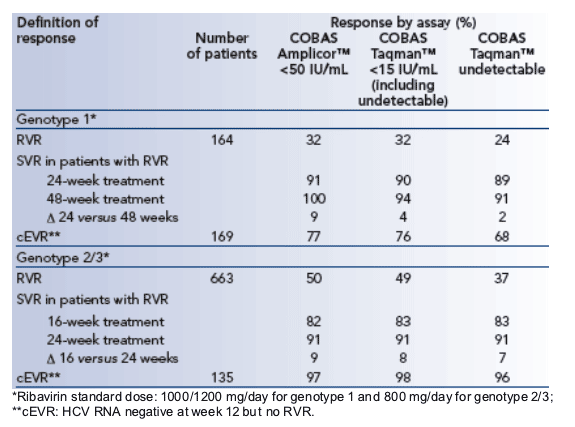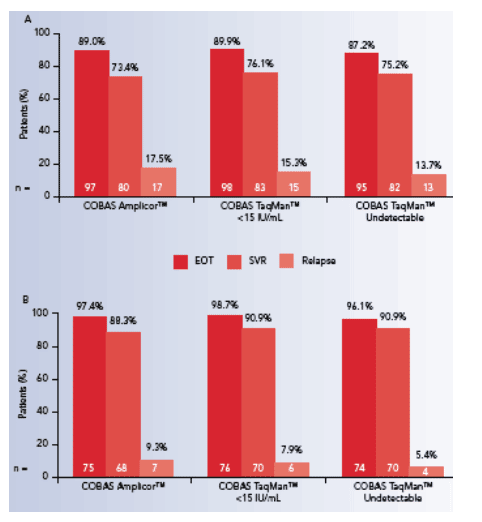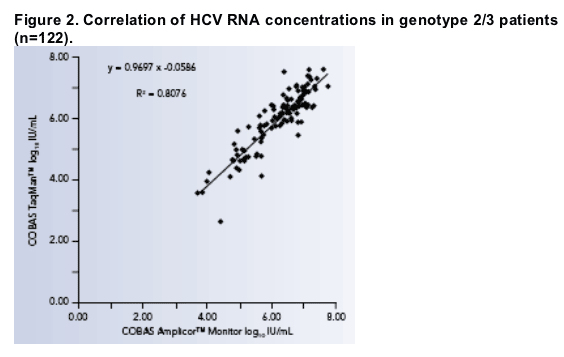 |
 |
 |
| |
What is the impact of higher sensitivity assay on response-guided therapy in hepatitis C virus (HCV)? Comparative analysis between COBAS TaqMan™ and COBAS Amplicor™ tests from two large, randomized, international trials of PEGASYS plus COPEGUS
|
| |
| |
Reported by Jules Levin
AASLD, Nov 2-6, 2007, Boston, MA
C. Sarrazin,1 M.L. Shiffman,2 S.J Hadziyannis,3 A. Lin,4 G. Colucci,5 H. Ishida,6 S. Zeuzem1
1Department of Internal Medicine, J. W. Goethe-University Hospital, Frankfurt, Germany; 2Hepatology Section, Virginia Commonwealth University Medical Center, Richmond, VA, USA; 3Henry Dunant Hospital, Athens, Greece;
4Roche, Nutley, NJ, USA; 5Roche Molecular Systems-RDR, Rotkreuz, Switzerland; 6Roche, Basel, Switzerland
This research was funded by Roche, Basel, Switzerland.
CONCLUSIONS
In this study, rates of RVR and cEVR as determined with the COBAS TaqMan™ (<15 IU/mL [including undetectable]) and COBAS Amplicor™ (<50 IU/mL) assays were similar.
This indicates that in the majority of patients achieving an RVR, HCV RNA levels rapidly decline not only to below 50 IU/mL but also below 15 IU/mL. Despite expectations that higher SVR rates might be observed when the more sensitive COBAS TaqMan™ assay was used to define RVR, SVR rates for patients with an RVR were also comparable, irrespective of genotype.
In terms of quantitative points, EVR rates measured with COBAS TaqMan™ also correlated well with those obtained using COBAS Amplicor™ Monitor in genotype 1 and genotype 2/3 patients, as did baseline viral loads measured in genotype 2/3 patients.
These results indicate that COBAS TaqMan™ can be used in place of COBAS Amplicor™ in response-guided therapy - a detection limit of <15 IU/mL serves as a reasonable definition of RVR and cEVR. Measurement of these responses at weeks 4 and 12 using this method can thus be used to determine optimal treatment durations for individual patients.
Interestingly, relapse rates were always lower in patients with undetectable HCV RNA at EOT by COBAS TaqMan™ in comparison with COBAS Amplicor™. Whilst the COBAS TaqMan™ undetectable cut-off may be advantageous in terms of defining week 4, 12, 24 and EOT responses and predicting relapse rates, further prospective studies with large number of patients are required to fully investigate its significance.
INTRODUCTION
The clinical management of hepatitis C (HCV) infection is rapidly evolving from a fixed duration of pegylated interferon plus ribavirin, as determined by genotype,[1] to response-guided therapy.[2-7] In the latter, treatment durations are adjusted according to patients' genotype, baseline viral load and on-treatment virologic responses at weeks 4 and 12, as defined below:
- Rapid virologic response (RVR): HCV RNA negative (<50 IU/mL) at week 4.
- Complete early virologic response (cEVR): HCV RNA negative (<50 IU/mL) at week 12, but no RVR.
- Partial early virologic response (pEVR): ≥2 drop log10 in HCV RNA level from
baseline at week 12, but no RVR or cEVR.
Response-guided therapy was originally based on early signal and target amplification assays such as the polymerase chain reaction (PCR)-based qualitative COBAS Amplicor™ HCV Test version 2.0 (50 IU/mL detection limit) and quantitative COBAS Amplicor™ Monitor HCV Test version 2.0, as well as transcription-mediated amplification and bDNA based assays such as the Versant® HCV RNA assays.[8] Newer real-time PCR assays, such as COBAS Ampliprep®- COBAS TaqMan™ (CAP-CTM) HCV Test (15 IU/mL detection limit)
for highly sensitive HCV RNA detection and precise quantification, are now available.[9]
To assess the impact of the more sensitive COBAS TaqMan™ HCV Test on rates of on-treatment responses, we compared COBAS Amplicor™- and COBAS TaqMan™-based measurements from two randomized, double-blind, multinational HCV trials[1,10] including an analysis of differences in HCV RNA quantification at baseline using both assays.
METHODS
Sample selection
Stored serum samples from HCV patients enrolled in two randomized, multinational clinical trials of peginterferon alfa-2a (40KD) plus ribavirin were obtained.
- Study NV15942: genotype 1 and non-genotype 1 patients received 180 _g/week peginterferon alfa-2a (40KD) plus ribavirin (800 mg/day or 1000/1200 mg/day) for 24 or 48 weeks.[1]
- The ACCELERATE trial (NV17317): genotype 2 or 3 patients received 180 _g/week peginterferon alfa-2a (40KD) plus ribavirin (800 mg/day) for 16 or 24 weeks.[9]
Samples from study NV15942 were selected for re-analysis by COBAS TaqMan™ if they were of sufficient volume at all time points (baseline, week 4, week 12, end of treatment [EOT] and end of follow-up [EOF]) (n=629).
Samples from the ACCELERATE trial were selected for re-analysis by COBAS
TaqMan™ if they were of sufficient volume at baseline (n=122) and week 4 (n=663).
Assessments and endpoints
HCV RNA concentrations of selected samples had been previously analyzed using the COBAS Amplicor™ HCV Test, version 2.0 (detection limit 50 IU/mL) for qualitative assessment and the COBAS Amplicor™ HCV Monitor, version 2.0 for quantitative assessment.[1,9] These samples were re-analyzed for comparison using the COBAS TaqMan™ HCV Test in this study, with two different detection limits:
- COBAS TaqMan™ undetectable (truly negative)
- COBAS TaqMan™ <15 IU/mL (positive but below 15 IU/mL plus truly negative)
Only samples from patients treated with standard doses of ribavirin according to
genotype (1000/1200 mg/day for genotype 1 and 800 mg/day for genotype 2/3)
were analyzed in this analysis.
Rates of RVR (HCV RNA negative at week 4) and SVR (HCV RNA negative at 24 weeks post-treatment) in patients with an RVR measured by both assays were compared for genotype 1 patients from study NV15942 (n=164) and genotype 2/3 patients from the ACCELERATE trial (n=663).
Rates of cEVR (HCV RNA negative at week 12) and EVR (HCV RNA negative or
≥2-log drop from baseline) determined by both assays were compared for
genotype 1 (n=169) and genotype 2/3 (n=135) patients from study NV15942.
Relapse rates determined with both assays were compared for genotype 1 (n=109) and genotype 2/3 (n=77) patients in the standard treatment duration, standard ribavirin dose (i.e. according to genotype) group from study NV15942.
Baseline viral loads measured using both assays were compared for genotype 2/3 patients from ACCELERATE.
RESULTS
RVR rates
RVR rates observed using COBAS TaqMan™ (<15 IU/mL [including undetectable]) and COBAS Amplicor™ (<50 IU/mL) were comparable, regardless of genotype (Table 1).
- Genotype 1 patients: 32% (52/164) versus 32% (52/164).
- Genotype 2/3 patients: 49% (323/663) versus 50% (329/663).
RVR rates observed using COBAS TaqMan™ (undetectable) were slightly lower than those observed using COBAS Amplicor™ (<50 IU/mL), regardless of genotype (Table 1).
SVR rates in patients with an RVR
SVR rates in patients with an RVR observed using COBAS TaqMan™ (<15 IU/mL [including undetectable]) and COBAS AmplicorTM (<50 IU/mL) were similar, regardless of genotype and treatment duration (Table 1).
- Genotype 1 treated for 24 weeks: 90% (19/21) versus 91% (20/22).
- Genotype 1 treated for 48 weeks: 94% (30/32) versus 100% (30/30).
- Genotype 2/3 treated for 16 weeks: 83% (108/130) versus 82% (146/179).
- Genotype 2/3 treated for 24 weeks: 91% (137/150) versus 91% (136/150).
SVR rates observed using COBAS TaqMan™ (undetectable) were also similar to those observed using COBAS Amplicor™ (<50 IU/mL) (Table 1).
Table 1. RVR, cEVR and SVR in patients with an RVR observed with COBAS
Amplicor™ (<50 IU/mL), COBAS Taqman™ (<15 IU/mL [including undetectable]) and COBAS TaqMan™ (undetectable)

Correlation of early virologic response rates
cEVR rates observed in study NV15942 were similar with both assays and each lower detection limit (<50 IU/mL, <15 IU/mL [including undetectable], undetectable) except cEVR rates in genotype 1 based on the undetectable definition (Table 1).
Rates of cEVR or EVR by each assay and lower detection limit are summarized in Table 2.
- A comparison of COBAS Amplicor™ (<50 IU/mL) with COBAS TaqMan™ (<15 IU/mL [including undetectable]) showed a match in cEVR results for 95% of genotype 1 patients and 99% of genotype 2/3 patients (Table 2A).
- Comparing COBAS Amplicor™ (<50 IU/mL) with COBAS TaqMan™ (undetectable) showed a match in cEVR results for 87% of genotype 1 patients and 97% of genotype 2/3 patients (Table 2B).
- A comparison of COBAS Amplicor™ Monitor with COBAS TaqMan™ showed a
match in EVR results for 99% of genotype 1 patients and 100% of genotype 2/3
patients (Table 2C).

Figure 1. End of treatment response (EOT), SVR and relapse rates in (A) genotype 1 and (B) genotype 2/3 patients (data derived from standard treatment group by genotype regardless of RVR or non-RVR).

Correlation of baseline viral loads
Baseline viral loads for genotype 2/3 patients from ACCELERATE measured using COBAS TaqMan™, correlated well with those measured using COBAS Amplicor™ Monitor (R2 = 0.8076) (Figure 2).

REFERENCES
1. Hadziyannis SJ, Sette H, Jr., Morgan TR, et al. Peginterferon-alpha2a and ribavirin combination therapy in chronic hepatitis C: a randomized study of treatment duration and ribavirin dose. Ann Intern Med 2004;140:346-355.
2. Jensen DM, Morgan TR, Marcellin P, et al. Early identification of HCV genotype 1 patients responding to 24 weeks peginterferon alpha-2a (40 kd)/ribavirin therapy. Hepatology 2006; 43:954-960.
3. Ferenci P, Bergholz U, Laferl H, et al. Customizing treatment with peginterferon alfa-2a (40KD) (PEGASYS) plus ribavirin (COPEGUS) in patients with HCV genotype 1 or 4 infection. Interim results of a prospective randomized trial. J Hepatol 2006; 44(Suppl 2):S6.
4. Sanchez-Tapias JM, Ferenci P, Diago M, Romero-Gomez M, Zeuzem S, Berg T. How can we identify HCV genotype 1 patients who may benefit from an extended treatment duration with peginterferon-2a (40 kD) plus RBV? J Hepatol 2007; 46(Suppl 1):S242.
5. Shiffman ML, Nelson D, Harley H, et al. Impact of Genotype, On-treatment Response & Viral Load on SVR With Peginterferon alfa-2a Plus RBV. 17th APASL; Hep Intl 2007; 1:34, Abstract 0-182.
6. Willems B, Hadziyannis SJ, Morgan TR, et al. Should treatment with peginterferon plus ribavirin be intensified in patients with HCV genotype 2/3 without a rapid virologic response? J Hepatol 2007; 46 (Suppl): S6
7. Marcellin P, Hadziyannis SJ, Berg T, et al. Virologic response at 4 and 12 weeks predict high rates of sustained virologic response in genotype 1 patients treated with peginterferon alfa-2a (40KD) plus ribavirin. J Hepatol 2007; 46:S231-S232.
8. http://diagnostics.siemens.com
9. Roche Molecular Systems. COBAS Ampliprep/COBAS COBAS TaqMan HCV Test. Product Information 2007.
10. Shiffman ML, Suter F, Bacon BR, et al. Peginterferon alfa-2a and ribavirin for 16 or 24 weeks in HCV genotype 2 or 3. N Engl J Med 2007; 357:124-134.
|
| |
|
 |
 |
|
|